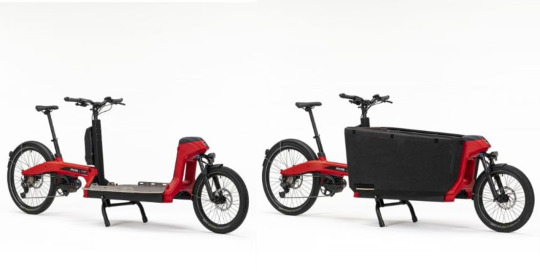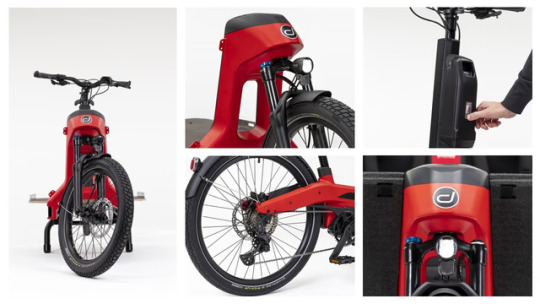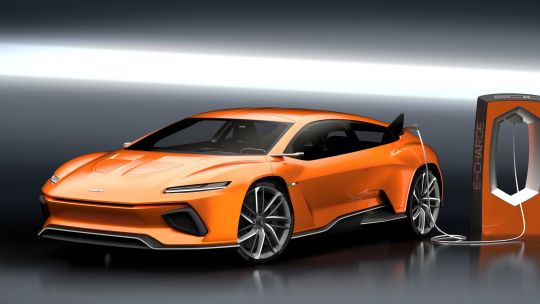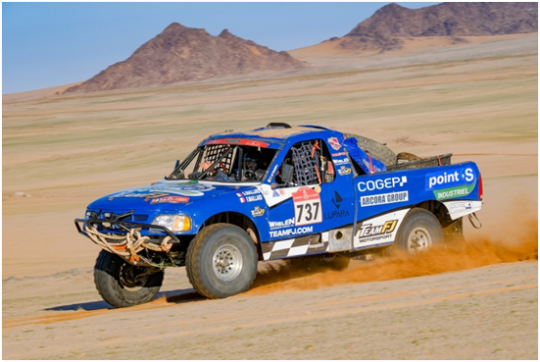#toyota ev 2021
Explore tagged Tumblr posts
Text
100kgまでOK。大人も乗せて運べるトヨタのeカーゴバイク | ギズモード・ジャパン

以下引用
メイド・イン・フランスのトヨタの自転車。 持続可能なモビリティーを促進するべく、2021年12月に大量の���未来バッテリーEVを発表したトヨタ。 世界的な自動車メーカーのトヨタですが、フランスではeバイクのDOUZE Cyclesと手を組み、脱炭素化社会を目指す電動カーゴバイク「DOUZE Cycles x Toyota Mobility」を発売します。
まるで走る風呂桶
荷台の部分には風呂桶のような300L容量のカゴを合体させられ、ここに荷物や大人ならひとり、子供なら3人を乗せて運ぶことができます。個人で使っても良いですし、企業が配達用に採用してもOKです。
荷台が850mmあるから長ーい
DOUZE Cyclesは、この分野で10年の経験があるとのこと。だからなのか、長いカーゴバイクがジャマにならないよう、中心でふたつに分解できて収納しやすくなります。 再利用したアルミを鋳造したフレームは耐荷重100kg。ポリマー製の部品も再利用されたもので、全ての部品が交換可能など、サスティナブルは構造面にも及びます。部品がひとつ壊れたくらいでは、丸ごと廃棄することがないのでエコですね。もし捨てる時も分別できますし。
これは自転車界のプリウス
500Whの充電池は取り外すことができ、4時間でフル充電に。最長で100kmの距離を走るので、50km先まで出かけて帰って来たらピッタリです。 センタースタンドはワイドで積み下ろしが安定し、低重心なので走行中も安定感があります。ディスクブレーキの制動力で安全性もバッチリです。

ディレイラーはシマノの10速ですが、外見などから察するにモーターはヤマハが作るヨーロッパ仕様の250W「PW-X3」であると思われます。これだと最高時速が25kmなので、日本だとバイク扱いになってしまいます。とはいえヤマハもトヨタも日本の会社なので、日本版が期待できるかもしれませんね。
3 notes
·
View notes
Text
https://www.reuters.com/business/autos-transportation/tesla-lay-off-more-than-10-its-staff-electrek-reports-2024-04-15/
BERLIN, April 15 (Reuters) - Tesla (TSLA.O), opens new tab is laying off more than 10% of its global workforce, an internal memo seen by Reuters on Monday shows, as it grapples with falling sales and an intensifying price war for electric vehicles (EVs).
"About every five years, we need to reorganize and streamline the company for the next phase of growth," CEO Elon Musk commented in a post on X. Two senior leaders, battery development chief Drew Baglino and vice president for public policy Rohan Patel, also announced their departures, drawing posts of thanks from Musk although some investors were concerned.
Musk last announced a round of job cuts in 2022, after telling executives he had a "super bad feeling" about the economy. Still, Tesla headcount has risen from around 100,000 in late 2021 to over 140,000 in late 2023, according to filings with U.S. regulators.
Baglino was a Tesla veteran and one of four members, along with Musk, of the leadership team listed on the company's investor relations website.
Scott Acheychek, CEO of Rex Shares - which manages ETFs with high exposure to Tesla stock - described the headcount reductions as strategic, but Michael Ashley Schulman, chief investment officer at Running Point Capital Advisors, deemed the departures of the senior executives as "the larger negative signal today" that Tesla's growth was in trouble.
Less than a year ago, Tesla's chief financial officer, Zach Kirkhorn, left the company, fueling concerns about succession planning.
Tesla shares closed 5.6% lower at $161.48 on Monday. Shares of EV makers Rivian Automotive (RIVN.O), opens new tab, Lucid Group (LCID.O), opens new tab and VinFast Auto also dropped between 2.4% and 9.4%.
"As we prepare the company for our next phase of growth, it is extremely important to look at every aspect of the company for cost reductions and increasing productivity," Musk said in the memo sent to all staff.
"As part of this effort, we have done a thorough review of the organization and made the difficult decision to reduce our headcount by more than 10% globally," it said.
Reuters saw an email sent to at least three U.S. employees notifying them their dismissal was effective immediately.
Tesla did not immediately respond to a request for comment.
MASS MARKET
The layoffs follow an exclusive Reuters report on April 5 that Tesla had cancelled a long-promised inexpensive car, expected to cost $25,000, that investors have been counting on to drive mass-market growth. Musk had said the car, known as the Model 2, would start production in late 2025.
Shortly after the story published, Musk posted "Reuters is lying" on his social media site X, without detailing any inaccuracies. He has not commented on the car since, leaving investors and analysts to speculate on its future.
Tech publication Electrek, which first reported, opens new tab the latest job cuts, said on Monday that the inexpensive car project had been defunded and that many people working on it had been laid off.
Reuters also reported on April 5 that Tesla would shift its focus to self-driving robotaxis built on the same small-car platform. Musk posted on X that evening: "Tesla Robotaxi unveil on 8/8," with no further details.
Tesla could be years away from releasing a fully autonomous vehicle with regulatory approval, according to experts in self-driving cars and regulation.
Tesla shares have fallen about 33% so far this year, underperforming legacy automakers such as Toyota Motor (7203.T), opens new tab and General Motors (GM.N), opens new tab, whose shares have rallied 45% and about 20% respectively.
Energy major BP (BP.L), opens new tab has also cut more than a tenth of the workforce in its EV charging business after a bet on rapid growth in commercial EV fleets did not pay off, Reuters reported on Monday, underscoring the broader impact of slowing EV demand.
WORKS COUNCIL
A newly elected works council of labour representatives at Tesla's German plant was not informed or consulted ahead of the announcement to staff, said Dirk Schulze, head of the IG Metall union in the region.
"It is the legal obligation of management not only to inform the works council but to consult with it on how jobs can be secured," Schulze said.
Analysts from Gartner and Hargreaves Lansdown said the cuts were a sign of cost pressures as the carmaker invests in new models and artificial intelligence.
Tesla reported this month that its global vehicle deliveries in the first quarter fell for the first time in nearly four years, as price cuts failed to stir demand.
The EV maker has been slow to refresh its aging models as high interest rates have sapped consumer appetite for big-ticket items, while rivals in China, the world's largest auto market, are rolling out cheaper models.
China's BYD (002594.SZ), opens new tab briefly overtook the U.S. company as the world's largest EV maker in the fourth quarter, and new entrant Xiaomi (1810.HK), opens new tab has garnered substantial positive press.
Tesla is gearing up to start sales in India, the world's third-largest auto market, this year, producing cars in Germany for export to India and scouting locations for showrooms and service hubs in major cities.
Tesla recorded a gross profit margin of 17.6% in the fourth quarter, the lowest in more than four years.
2 notes
·
View notes
Text
Toyota posts nearly 20% drop in second-quarter operating profit, missing estimates
A Toyota bZ Compact SUV is pictured after a briefing on EV (electric vehicle) battery strategies at the companys showroom in Tokyo on December 14, 2021. Behrouz Mehri | Afp | Getty Images Japanese automaker Toyota Motor on Wednesday reported its first quarterly operating profit drop in about two years, as it strives to navigate the market shift toward electric vehicles. Here are Toyota’s results…

View On WordPress
0 notes
Text
Toyota posts nearly 20% drop in second-quarter operating profit, missing estimates
A Toyota bZ Compact SUV is pictured after a briefing on EV (electric vehicle) battery strategies at the companys showroom in Tokyo on December 14, 2021. Behrouz Mehri | Afp | Getty Images Japanese automaker Toyota Motor on Wednesday reported its first quarterly operating profit drop in about two years, as it strives to navigate the market shift toward electric vehicles. Here are Toyota’s results…
0 notes
Text
BEST CARS (update) (edit) - autod-final - new version
Minul pole raha et autot osta. (aga norm auto peab olema - Midagi pole arusaamatut) ( Üks ameeriklanna vastas ka et, wtf Kas sa oled tuleviku-lennuki-piloot ja pani bloki, .. - Vist mingid mängud, ma arvan. BOLT-taksot ma ka sõita ei saa - kliendid panid "madala hinnangu" ) info eest võiks "Aitäh" öelda, mitte "mind ei huvita" "käi putsi, mul on mäng pooleli" vms
BEST CARS (update) - hetke lühi-kokkuvõte: Google Search , wikipedia, youtube -
siis võtad oma Mercedese skänneri kaasa ja lähed saksa
kontrollitud ajalugu (history) auto-esinduses warranty (Toyota garantii USA's 10 aastat)
Audi saab kiirteel juhitavuse tagasi - ESP ABS jms Volvo vedrustus/sillad on head - alumiiniumist õõtshoovad jms .. jne
(( Car criteria must be - Simple Economical Easy-To-Fix (efficient, comfortable, reliable) ))
MAINTENANCE COSTS (hooldus)
www.edmunds.com/tco.html TCO (Total Cost to Own) Ownership Costs: 5-Year Breakdown
Auto vanus - 5-10 aastat, Maksimum läbisõit 150 000 - 190 000
auto24.ee mobile.de nettiauto.fi autorola.eu
www.theparking.eu
Holland, Belgia, Rootsist või Saksamaalt
!!! a hybrid vehicle defies the purpose of owning an Electric Vehicle … Efficiency and Reliability figures arise only from electric efficiency and the fact that EV doesn't have an Internal Combustion Engine !!! (Hübriid trotsib elektrisõiduki omamise eesmärki … tõhususe ja töökindluse näitajad tekivad ainult asjaolust, et EV -l pole sisepõlemismootorit)
Mercedes-Benz Vision EQXX - most efficient car ever made
1,75 eur liiter 95, 98, diisel Tallinnas 0,35 €/kWh Alexela laadija 35 senti kWh - 6,3€/100km Volt ülikiire 24 senti kWh - 4,3€/100km Eleport tava $0.12/kWh for electricity at home in California $3.50/gallon for gasoline.
! Tesla laadimine USA's tasuta !
====================
--- Electric EV ---
2023 Cadillac Lyriq 2024 Chevrolet Equinox EV Audi RS e-tron GT Audi Q4 e-tron Audi SQ8 e-tron BMW iX BMW i4 Porsche Taycan Tesla Model 3 - ! Tesla laadimine USA's tasuta ! Tesla Model Y - ! Tesla laadimine USA's tasuta ! Hyundai IONIQ 5 Kia EV6 Honda e Nissan Leaf MG ZS EV MG MG5 EV Opel Mokka-e Mercedes-Benz EQS Mini Electric Jaguar I‑PACE Skoda Enyaq iV Renault Megane E-Tech electric Peugeot e-2008 Volkswagen ID.3 vw e-up vw e-golf VW ID. Buzz Ford F-150 Lightning ev Chevrolet Silverado EV
Volvo XC40 Recharge
====================
2021 Volvo XC60 Recharge Plug-in Hybrid T6 Essential AWD Geartronic 2020 Volvo V60 Cross Country D4 AWD Automat Momentum Kombi - 24000eur 2020 Toyota Harrier Plug-in Hybrid (lithium-ion battery) Lexus RX 450h+ PHEV - USA's populaarne Lexus NX
2020 Mercedes GLE 450 (m256 inline6) 2022 Mercedes GLC 350e PHEV hybrid plugin
====================
--- >>> 2010-2012 GLK 250 CDI 4MATIC BlueEFFICIENCY <<< --- 2015 Mercedes GLK 220 CDI BlueTEC 4Matic >> OM651.921 (2.1) diesel !! << GLK 220 CDI !!! <<< <<<
BEST CAR EVER MADE - Mercedes-Benz G-Klasse AMG Geländewagen
1996–1998 Mercedes S-klass S320 (W140) 300 SE/300 SEL , S 320 (M104 Straight-6 engine 190–276 hp) -- not economical 2018 KIA Optima diisel 15000eur 2011 MB ML350 2020 Mercedes-Benz GLE350 4MATIC 2022 Subaru Crosstrek Plug-In Hybrid Subaru WRX impreza STi BMW X5 Audi S5 Audi S7 Mercedes CLS AMG Lexus IS 300h
Audi A4 2.5TDI Audi A4 2008-2016 3.0L V6 TFSI - Audi vajab ennetavat hooldust ja teadmisi Audi Q5 Toyota Prius 2010 Toyota Camry hybrid Toyota RAV4 Ford Mondeo 2001-2003 Mercedes C-klass Mercedes-Benz V Honda Jazz 2009 2nd Gen Honda Accord 2003–2006 K20A6 Honda Accord 2003-2008 2.4i vtec Honda cr-v Lexus IS 200 Lexus is 250 2008 2nd gen Volvo v50 T-5
====================
Takso sõitmiseks: Toyota Camry hybrid (palju toodetud, sobib taksoks) MB E-klass 2012-2014 (palju toodetud, sobib taksoks)
====================
auto.geenius.ee Kasutatud autode TOP 15: need pruugitud sõidukid pakuvad Eesti lugejale enim huvi
BMW 3. seeria E9x
Škoda Superb
Mercedes V-klass
BMW X3
Dodge Challenger SRT
Volkswagen Passat B8
Subaru Outback
Mercedes-Benz GL-klass
Jeep Grand Cherokee
Volvo XC70
Ford Mondeo
Mazda 6
Audi A6
Chrysler Grand Voyager
Volvo XC90 ja Volvo S90/V90
0 notes
Text
V1.42 Launch CRT5011E TPMS Tool Update
Launch CRT5011E TPMS Tire Pressure Tool 315MHz/433MHz V1.42 update, get the newest update.

V1.42 New Update Info:
Audi: 2024 e-tron GT BAIC: 2024 EU5, 2024 X7 BAIC Foton: 2024 Mars 7, 2024 Mars 9 BAIC: 2024 Yuanbao BYD: 2022 E5, 2024 E9, 2022 F3, 2024 Corvette 07, 2016 Si Rui, 2017 G6, 201 2019 M3, 2018 S7, 2024 Han DM-p, 2024 Han, 2024 Qin, 2024 Destroyer 05, 2024 Song, 2022 Tang, 2024 Tang DM-p, 2024 Yuan, 2024 Yuan UP Peugeot: 2024 508L Buick: 2020 GL8, 2019 LaCrosse, 2024 Verano Pro, 2022 Excelle Changan: 2024 CS15, 2021 CS55 E- Rock, 2024 CS75 PLUS, 2022 CS85, 2023 CS95, 2024 F70, 2024 Hunter, 2021 Neo II, 2023 Oushang A600, 2022 Oushang COSMOS EV, 2022 Oushang X7EV, 2024 Qiyuan A06, 2024 Qiyuan A05, 2024 CS55 PLUS, 2020 Ounuo S, 2021 Eado EV, 2021 Eado XT, 2023 Yuexiang Great Wall: 2019 King Kong Cannon, 2024 Tank 700, 2024 Weipai Alpine Dodge: 2024 Ram 1500 Dongfeng: 2022 E3EV Dongfeng Nano: 2023 BOX Toyota: 2024 Hiace, 2024 Lingshang, 2024 Land Cruiser Haval: 2022 H6 Chevrolet: 2024 Explorer Geely: 2024 Boyue L, 2021 Emgrand EV Pro, 2024 Geometry A, 2024 Geometry G6, 2022 GE11 EX3, 2021 Geometry T, 2024 Galaxy E8, 2024 Ruilan 7, 2024 Ruilan 9, 2024 VF11 L Jeep: 2023 Wagoneer JAC: 2023 IEV 6E, 2024 T8, 2024 T9, 2020 Ruifeng S2 Jaguar: 2022 XF Jinbei: 2022 New Hiace Arcfox: 2024 Alfa S, 2023 Alfa S HI, 2023 Alfa T Renault: 2019 Clio 4, 2019 Espace V, 2023 Kangoo II, 2016 Koleos, 2022 KOLEOS II/QM6, 2022 K-Ze, 2024 Megane 4, 2017 Talisman Lincoln: 2024 Z Lynk & Co: 2024 01, 2024 02, 2022 03, 2024 Model 05 Mazda: 2024 CX-8 Chery: 2024 EQ1 Venucia: 2024 D60, 2024 D60 EV PLUS, 2024 D60 PLUS, 2020 T 70, 2024 V-ONLINE, 2024 VX6, 2024 Star Nissan: 2020 GT-R, 2019 Patrol Roewe: 2024 D5X, 2024 D7 Dengshi: 2024 D9, 2024 N8 GM: 2024 Yukon Hyundai: 2023 Kona N Chevrolet: 2024 Traverse, 2024 Trax, 2024 Trax EV, 2024 Camaro, 2022 Malibu, 2020 Malibu XL, 2024 Tracker Citroën: 2024 C6
Added and optimized sensor models ●2024 BYD Song ●2024 Peugeot 508L ●2024 Ford F-Series SD DRW ●2021 Feifan Er6 ●2020 Geely EC7, 2017 SC6, 2014 SX7, 2024 TX5, 2019 Emgrand, 2012 British King Kong ●Activation and programming of some models of Roewe and MG from 2017 to 2024 Function
How to update Launch CRT5011E TPMS Tool
0 notes
Text
Electric Vehicle (EV) Platform Market Estimated to Reach Revenue of US$ 65.5 Billion by the End of 2031
The global electric vehicle (EV) platform market is likely to grow at a CAGR of 24.6% from 2022 to 2031. The EV platform is a charging station consisting of underbody components and suspension. The vehicle's body and chassis are merged into the flooring, thereby ensuring that the EV remains lightweight. Increase in adoption of EVs across the world is projected to be a key factor propelling global electric platform (EV) platform industry.
Customizable EV platforms are being designed, modified, and constructed to support different EV models. EVs have now become more affordable owing to this technology. Customized EV platforms have low material cost offering superior performance. This is because modular electric vehicle platforms are designed, built, and modified for accommodating different variety of electric car models. Low operational and maintenance costs of EVs are projected to increase sales. This presents significant business opportunities in the electric vehicle (EV) platform market owing to the projected increase in the sales rate of EVs in the next few years.
According to TMR report, the global electric vehicle (EV) platform market stood at US$ 7.2 Bn in 2021 and is anticipated to reach US$ 65.5 Bn by the end of 2031. Rise in government support to set up charging stations for EVs is projected to bolster market expansion in the near future.
For More Details, Request for a Sample of this Research Report: https://www.transparencymarketresearch.com/ev-platform-market.html
Key Findings of Study
Imposition of Regulations on Internal Combustion Engines: Governments across the world have imposed strict emission standards on vehicles to minimize the harmful effects of exhaust fumes. Deployment of federal regulations that restrict gasoline and diesel-powered automobiles is one of the primary reasons for customers' shift toward EVs. This is projected to create significant business opportunities in the electric vehicle (EV) platform market during the forecast period.
Continuous Efforts in R&D to Lower Cost of Battery for EVs: The need for long lasting battery backup when the EV is on road is increasing as all EVs run on batteries. Rise in demand for zero-emission vehicles is projected to bolster the need for batteries in vehicles. This, in turn, is likely to bolster the electric vehicle (EV) platform market during the forecast period. Most manufacturers of the EV platform are investing significantly in research & development of better battery performance and battery packs that are affordable. This is likely to augment the global market for EV platform during the forecast period.
Key Drivers
Rise in demand for zero-emission vehicles is expected to boost the global market during the forecast period
Increase in adoption of new technologies for emission control is likely to augment the need for EV platform, thereby driving the global market
Regional Growth Dynamics
Asia Pacific accounted for dominant share of the global electric vehicle (EV) platform market in 2021. The trend is anticipated to continue during the forecast period owing to the presence of major vehicle manufacturers and OEMs in the region.
Expansion of production units and increase in focus on technological advancements in the EVs industry are projected to drive the electric vehicle (EV) platform market development during the forecast period
Key Players
Notable players in the global electric vehicle (EV) platform market are Zoyte, Volvo Cars, Volkswagen AG, Toyota Motor Corporation, SAIC Motor Corporation Limited, Rivian, Nissan Motor Corporation, Kia America Inc., JAC Motors, Hyundai Motor Company, Honda Motor Co. Ltd., Mercedes-Benz Group, Byton, BYD Company, BMW AG, BAIC Group, Tesla, Chery, Faraday &Future, Inc., Geely Auto, Honda Motor, and Fisker, Inc.
Electric Vehicle (EV) Platform Market Segmentation
Component
Chassis
Battery
Suspension System
Steering System
Drivetrain
Vehicle Interior
Others
Electric Vehicle (EV) Type
Battery Electric Vehicle (EV)
Hybrid Electric Vehicle (EV)
Platform
P0
P1
P2
P3
P4
Vehicle Type
Passenger Vehicle
Hatchback
Sedan
Utility Vehicle
Light Commercial Vehicle
Heavy Duty Truck
Bus & Coach
Sales Channel
OEM
Aftermarket
Region
North America
Europe
Asia Pacific
Middle East & Africa
South America
Buy this Premium Research Report: https://www.transparencymarketresearch.com/checkout.php?rep_id=68843<ype=S
About Transparency Market Research
Transparency Market Research, a global market research company registered at Wilmington, Delaware, United States, provides custom research and consulting services. Our exclusive blend of quantitative forecasting and trends analysis provides forward-looking insights for thousands of decision makers. Our experienced team of Analysts, Researchers, and Consultants use proprietary data sources and various tools & techniques to gather and analyses information.
Our data repository is continuously updated and revised by a team of research experts, so that it always reflects the latest trends and information. With a broad research and analysis capability, Transparency Market Research employs rigorous primary and secondary research techniques in developing distinctive data sets and research material for business reports.
Contact:
Transparency Market Research Inc.
CORPORATE HEADQUARTER DOWNTOWN,
1000 N. West Street,
Suite 1200, Wilmington, Delaware 19801 USA
Tel: +1-518-618-1030
USA – Canada Toll Free: 866-552-3453
Website: https://www.transparencymarketresearch.com
0 notes
Text
The Electric Vehicle (EV) Market: Trends, Key Players, and Future Outlook
The Electric Vehicle (EV) market represents one of the most dynamic and rapidly evolving sectors within the global automotive industry. As the world faces increasing environmental challenges and a pressing need to reduce carbon emissions, the shift towards electric mobility has become not just desirable but essential. This blog explores the latest trends shaping the EV market, identifies key players driving the industry's growth, and provides a forward-looking analysis of the market's future trajectory.
Market Trends
The EV market has been characterized by several key trends that are reshaping the automotive landscape. These trends are not only influencing consumer preferences but are also driving the strategic decisions of automakers, governments, and investors.

1. Acceleration of Government Regulations and Incentives
Governments across the globe are implementing stringent regulations and offering substantial incentives to promote the adoption of electric vehicles. Policies such as tax rebates, subsidies, and emission reduction targets are creating a favorable environment for the growth of the EV market.
Europe: The European Union's commitment to becoming climate-neutral by 2050 is a significant driver of EV adoption in the region. The EU's Green Deal and the ban on the sale of new internal combustion engine (ICE) vehicles by 2035 are pushing both manufacturers and consumers towards electric mobility.
China: As the world's largest automotive market, China has been at the forefront of the EV revolution. The Chinese government has introduced policies such as the New Energy Vehicle (NEV) mandate, which requires automakers to produce a certain percentage of EVs, thus fueling the market's growth.
United States: The U.S. has seen a renewed focus on electric vehicles under the Biden administration, with ambitious plans to achieve net-zero emissions by 2050. Federal incentives, along with state-level programs like California's Zero Emission Vehicle (ZEV) mandate, are accelerating EV adoption across the country.
2. Advancements in Battery Technology
Battery technology is the backbone of the EV market, and ongoing advancements are critical to the industry's growth. The focus is on improving energy density, reducing charging times, and lowering costs.
Solid-State Batteries: One of the most promising developments in battery technology is the advent of solid-state batteries. These batteries offer higher energy density, faster charging, and enhanced safety compared to traditional lithium-ion batteries. Companies like QuantumScape and Toyota are leading the charge in bringing solid-state batteries to market, which could revolutionize the EV industry.
Cost Reduction: The cost of EV batteries has decreased significantly over the past decade, making electric vehicles more affordable. The price of lithium-ion battery packs fell from over $1,000 per kWh in 2010 to around $137 per kWh in 2021. This trend is expected to continue, with costs projected to drop below $100 per kWh by 2025, further reducing the price gap between EVs and ICE vehicles.
3. Expansion of Charging Infrastructure
The availability and accessibility of charging infrastructure remain crucial to the widespread adoption of electric vehicles. The expansion of both public and private charging networks is a key trend that is enabling the growth of the EV market.
Fast Charging Networks: Companies like Tesla, ChargePoint, and Electrify America are rapidly expanding their fast-charging networks, which are capable of charging EVs in a fraction of the time required by standard chargers. The development of ultra-fast chargers, capable of delivering up to 350 kW, is particularly significant, as it reduces charging times to around 15-20 minutes for a full charge.
Wireless Charging: Wireless or inductive charging is an emerging technology that could transform the way EVs are charged. By eliminating the need for physical connectors, wireless charging offers a more convenient and seamless charging experience. Automakers such as BMW and Hyundai are exploring wireless charging solutions, with pilot projects already underway.
4. Rise of Autonomous Electric Vehicles
The convergence of electric mobility and autonomous driving technology is poised to redefine the future of transportation. Autonomous Electric Vehicles (AEVs) offer the potential for increased safety, reduced traffic congestion, and lower operating costs.
Level 4 and 5 Autonomy: Companies like Waymo, Tesla, and General Motors are leading the development of fully autonomous vehicles (Levels 4 and 5). These vehicles, when combined with electric powertrains, are expected to revolutionize urban mobility, particularly in the context of ride-sharing and robo-taxi services.
AI and Machine Learning: The integration of artificial intelligence (AI) and machine learning into AEVs is enhancing their ability to navigate complex environments and make real-time decisions. These technologies are critical for the widespread deployment of autonomous electric vehicles on public roads.
Key Market Players
The global EV market is dominated by several key players who are driving innovation, scaling production, and competing for market share. These companies are not only leading in terms of sales but are also at the forefront of research and development, shaping the future of the EV industry.
1. Tesla, Inc.
Market Share: Tesla holds approximately 15% of the global EV market share, making it the undisputed leader in the industry.
Overview: Founded in 2003 by Elon Musk and others, Tesla has revolutionized the EV market with its high-performance electric vehicles, innovative technology, and a strong brand identity. Tesla's Model S, Model 3, Model X, and Model Y have set new benchmarks in the industry, with the Model 3 becoming the best-selling EV globally in 2021. Tesla's proprietary Supercharger network, coupled with its advancements in battery technology, continues to position the company as a market leader.
2. BYD Company Limited
Market Share: BYD holds around 13% of the global EV market, making it one of the largest EV manufacturers in the world.
Overview: BYD, a Chinese multinational, has been a major player in the electric vehicle market, offering a wide range of electric cars, buses, and commercial vehicles. The company's strength lies in its vertical integration, controlling both battery production and vehicle manufacturing. BYD's commitment to innovation is evident in its development of the Blade Battery, a new type of lithium-iron-phosphate (LFP) battery that enhances safety and performance.
3. Volkswagen Group
Market Share: Volkswagen holds approximately 6% of the global EV market share.
Overview: Volkswagen is making significant strides in the EV market with its ID series, which includes the ID.3, ID.4, and the upcoming ID. Buzz. The German automaker has committed to investing over $80 billion in electrification by 2025, with the goal of becoming a global leader in electric mobility. Volkswagen's Modular Electric Drive Matrix (MEB) platform is central to its EV strategy, enabling the production of a wide range of electric vehicles across different segments.
4. NIO Inc.
Market Share: NIO holds around 3% of the global EV market share, with a strong presence in the premium EV segment.
Overview: NIO, often referred to as the "Tesla of China," is a leading manufacturer of premium electric vehicles. The company's innovative battery-as-a-service (BaaS) model, which allows customers to lease batteries separately from the vehicle, has garnered significant attention. NIO's flagship models, including the ES8, ES6, and EC6, are known for their performance, luxury, and advanced technology.
5. Hyundai Motor Company
Market Share: Hyundai holds approximately 4% of the global EV market share.
Overview: Hyundai has emerged as a key player in the EV market with its Ioniq and Kona Electric models. The South Korean automaker is expanding its EV lineup under the Ioniq sub-brand, with plans to introduce several new electric models by 2025. Hyundai's commitment to hydrogen fuel cell technology, alongside battery electric vehicles, positions the company as a versatile player in the clean energy transition.
Conclusion
The Electric Vehicle market is at a pivotal moment in its evolution, with rapid advancements in technology, increasing government support, and growing consumer acceptance driving its expansion. Key trends such as the development of solid-state batteries, the expansion of charging infrastructure, and the rise of autonomous electric vehicles are set to shape the future of the industry. Leading companies like Tesla, BYD, Volkswagen, NIO, and Hyundai are not only competing for market share but are also pushing the boundaries of innovation, making electric vehicles more accessible, efficient, and appealing to consumers. However, the industry still faces challenges, including the need for further cost reductions, the expansion of charging networks, and the development of sustainable battery solutions.
0 notes
Text
The demand for semiconductor chips is booming with the rising demand for EVs and increased rate of investments towards the development of the EV ecosystem.
An ecosystem constitutes an interdependent group of enterprises, peoples, components, and infrastructure that works together in conjunction to form a sustainable community. Every factor of an ecosystem depends on every other factor either directly or indirectly for the community to sustain and thrive. The EV ecosystem market comprises vehicle connectivity, new business models, manufacturing practices, infrastructures, and sustainability. Building a successful and working ecosystem is the only way for accelerating the adoption rate of new energy vehicles, where electric vehicle manufacturers will have to amplify the network effect with other stakeholders in the mobility ecosystem.

The EV Semiconductor Market refers to the infrastructure, industries, and components that support the production, adoption, and operation of electric vehicles. It constitutes various elements, including charging infrastructure, battery manufacturing, raw material mining and logistics, vehicle manufacturing, software connectivity, and supportive government policies. This developing ecosystem is presenting ample growth and investment opportunities and one notable growth opportunity within the EV ecosystem is the expansion of charging infrastructure. For instance, as of September 2021, there were over 200,000 publically accessible charging infrastructures which are going to grow at a significant rate by 2030. Investment opportunities within the EV ecosystem are diverse and span various sectors such as charging infrastructure companies, battery technology and manufacturing firms, electric vehicle manufacturers, and raw material mining companies. Additionally, investments in software and connectivity solutions for EVs, such as advanced driver assistance systems and V2X technologies, present promising avenues for growth
Reasons that will be playing out for driving the future growth of this industry:
Dynamic changes are underway in the automotive industry which will have a huge impact on how cars will be built and used. The impact of this shift will be experienced by the automakers and the consumers and will be enabled by the semiconductor industry. And the factors that are being played out by four megatrends reshaping the automotive industry are autonomy, electrification, vehicle connectivity, and mobility services, and will lead to a plethora of changes in the role of electronics in automotive designs and will lift the semiconductor industry with it. Moreover, for long past automakers are steadily adding electronics to increase safety, enhance comfort, and improve the fuel efficiency of the vehicle, where advanced driver assistance features such as adaptive cruise control, lane departure warning system, or blind spot assist have become a piece of standard equipment in today’s vehicle. Furthermore, the use of electricals and semiconductors has more than doubled with today’s nontraditional powertrains used in hybrid and fully electric vehicles. Additionally, with increasing autonomy, autonomous vehicles are getting equipped with LiDAR sensors, image-recognition systems, and 5G communication will further eight or ten-fold increase the use of semiconductor content in vehicles, giving a boost to the demand for semiconductors in the automotive industry. For instance, even low-range vehicles of today come with at least 30 microprocessor-controlled devices also known as ECUs, and in luxury cars, the numbers could go up to even more than 100 ECUs, and Toyota high-end vehicles nowadays are coming packed with 100 million lines of computer code, more than even some fighter jets.
Request Free Sample Pages with Graphs and Figures Here https://univdatos.com/get-a-free-sample-form-php/?product_id=44478
Conclusion:
In conclusion, the EV Semiconductor market is poised to grow at this conjuncture due to the increasingly stringent emission norms, the growing awareness, and the increasing expenditure with rising discretionary income. The market is segmented into types, the power management segment holds the majority of the market share owing to the fact that they are the key to extending an EVs driving range, to making battery charge last as long as possible. BEV is anticipated to witness a significant CAGR during the forecast period. With the automobile sector electrifying itself at a faster pace, EV semiconductors is going to be crucial for sustained growth and is one of the biggest enablers of this shift, and have an application in charging infrastructure, better and safe battery technology, and high-quality services that manufacturers and infrastructure service providers need to deliver to the consumers, which will require innovations and continuous research and developments aligned with specific customer needs.
Contact Us:
UnivDatos Market Insights
Email - [email protected]
Contact Number - +1 9782263411
Website -www.univdatos.com
0 notes
Text

The hydrogen FCV Toyota Mirai...
P.S. WTF!? This is what legacy automakers call the future?
Quote: "Unlike gasoline (which is measured in liquid volume), Hydrogen is measured and sold by weight. In 2021, hydrogen station chain True Zero charged just $13.14 per kilogram of hydrogen. Today, it costs $36 per kg. That means a Mirai's 5.65 kg fuel tank costs about $203 to fill up from empty. Owners have said online that the real-world range of the Mirai is around 260 miles to a tank of hydrogen, quite a bit less than Toyota's claim of 402 miles. This works out to around $0.78 per mile, or around 19,230 miles until Toyota's fuel card is kaput."
Source: Toyota Hydrogen Future Is Crumbling As Owners File Lawsuits, Call For Buybacks (insideevs.com)
P.S. No, no, no! It is not a sustainable future! It is nonsense from 1990s. The Toyota is wasting time and resources on useless technology from late 20th century, when there was no mass production of lithium-ion and LFP batteries yet. As well unlike hydrogen, cheap electricity is available everywhere in modern society.
Modern EVs can easily go 260 miles in real traffic...hydrogen no longer has any economic or technical advantages in today's light passenger cars
0 notes
Text
US Electric Vehicle Market To Witness the Highest Growth Globally in Coming Years

The report begins with an overview of the US Electric Vehicle Market and presents throughout its development. It provides a comprehensive analysis of all regional and key player segments providing closer insights into current market conditions and future market opportunities, along with drivers, trend segments, consumer behavior, price factors, and market performance and estimates. Forecast market information, SWOT analysis, US Electric Vehicle Market scenario, and feasibility study are the important aspects analyzed in this report.
The US Electric Vehicle Market is experiencing robust growth driven by the expanding globally. The US Electric Vehicle Market is poised for substantial growth as manufacturers across various industries embrace automation to enhance productivity, quality, and agility in their production processes. US Electric Vehicle Market leverage robotics, machine vision, and advanced control technologies to streamline assembly tasks, reduce labor costs, and minimize errors. With increasing demand for customized products, shorter product lifecycles, and labor shortages, there is a growing need for flexible and scalable automation solutions. As technology advances and automation becomes more accessible, the adoption of automated assembly systems is expected to accelerate, driving market growth and innovation in manufacturing. U.S. Electric Vehicle Market Size, Share & COVID-19 Impact Analysis, By Vehicle Type (Passenger Cars, Commercial Vehicles) and Regional Forecast, 2021-2028
Get Sample PDF Report: https://www.fortunebusinessinsights.com/enquiry/request-sample-pdf/106396
Key Strategies
Key strategies in the US Electric Vehicle Market revolve around optimizing production efficiency, quality, and flexibility. Integration of advanced robotics and machine vision technologies streamlines assembly processes, reducing cycle times and error rates. Customization options cater to diverse product requirements and manufacturing environments, ensuring solution scalability and adaptability. Collaboration with industry partners and automation experts fosters innovation and addresses evolving customer needs and market trends. Moreover, investment in employee training and skill development facilitates seamless integration and operation of US Electric Vehicle Market. By prioritizing these strategies, manufacturers can enhance competitiveness, accelerate time-to-market, and drive sustainable growth in the US Electric Vehicle Market.
Major US Electric Vehicle Market Manufacturers covered in the market report include:
LIST OF KEY COMPANIES PROFILED:
BMW Group (Munich, Germany)
BYD Company Ltd. (Shenzhen, China)
Daimler AG (Stuttgart, Germany)
Ford Motor Company (Michigan, U.S.)
General Motors Company (Michigan, U.S.)
Nissan Motor Corporation (Kanagawa, Japan)
Tesla, Inc. (California, U.S.)
Toyota Motor Corporation (Toyota City, Japan)
Volkswagen AG (Wolfsburg, Germany)
Groupe Renault (Boulogne-Billancourt, France)
Favorable Government Subsidies & Strict Regulations on Vehicle Emissions to Augment Growth. Government policies offering attractive incentives for owning and operating electric vehicles will encourage EV sales by providing consumers with multiple advantages such as reduced prices, low registration fees, and free charging infrastructure. Additionally, various government bodies are levying import taxes, road taxes, and purchase taxes for importing measures to attract dominant players.
Trends Analysis
The US Electric Vehicle Market is experiencing rapid expansion fueled by the manufacturing industry's pursuit of efficiency and productivity gains. Key trends include the adoption of collaborative robotics and advanced automation technologies to streamline assembly processes and reduce labor costs. With the rise of Industry 4.0 initiatives, manufacturers are investing in flexible and scalable US Electric Vehicle Market capable of handling diverse product portfolios. Moreover, advancements in machine vision and AI-driven quality control are enhancing production throughput and ensuring product consistency. The emphasis on sustainability and lean manufacturing principles is driving innovation in energy-efficient and eco-friendly US Electric Vehicle Market Solutions.
Regions Included in this US Electric Vehicle Market Report are as follows:
North America [U.S., Canada, Mexico]
Europe [Germany, UK, France, Italy, Rest of Europe]
Asia-Pacific [China, India, Japan, South Korea, Southeast Asia, Australia, Rest of Asia Pacific]
South America [Brazil, Argentina, Rest of Latin America]
Middle East & Africa [GCC, North Africa, South Africa, Rest of the Middle East and Africa]
Significant Features that are under offering and key highlights of the reports:
- Detailed overview of the US Electric Vehicle Market.
- Changing the US Electric Vehicle Market dynamics of the industry.
- In-depth market segmentation by Type, Application, etc.
- Historical, current, and projected US Electric Vehicle Market size in terms of volume and value.
- Recent industry trends and developments.
- Competitive landscape of the US Electric Vehicle Market.
- Strategies of key players and product offerings.
- Potential and niche segments/regions exhibiting promising growth.
Frequently Asked Questions (FAQs):
► What is the current market scenario?
► What was the historical demand scenario, and forecast outlook from 2024 to 2030?
► What are the key market dynamics influencing growth in the Global US Electric Vehicle Market?
► Who are the prominent players in the Global US Electric Vehicle Market?
► What is the consumer perspective in the Global US Electric Vehicle Market?
► What are the key demand-side and supply-side trends in the Global US Electric Vehicle Market?
► What are the largest and the fastest-growing geographies?
► Which segment dominated and which segment is expected to grow fastest?
► What was the COVID-19 impact on the Global US Electric Vehicle Market?
Table Of Contents:
1 Market Overview
1.1 US Electric Vehicle Market Introduction
1.2 Market Analysis by Type
1.3 Market Analysis by Applications
1.4 Market Analysis by Regions
1.4.1 North America (United States, Canada and Mexico)
1.4.1.1 United States Market States and Outlook
1.4.1.2 Canada Market States and Outlook
1.4.1.3 Mexico Market States and Outlook
1.4.2 Europe (Germany, France, UK, Russia and Italy)
1.4.2.1 Germany Market States and Outlook
1.4.2.2 France Market States and Outlook
1.4.2.3 UK Market States and Outlook
1.4.2.4 Russia Market States and Outlook
1.4.2.5 Italy Market States and Outlook
1.4.3 Asia-Pacific (China, Japan, Korea, India and Southeast Asia)
1.4.3.1 China Market States and Outlook
1.4.3.2 Japan Market States and Outlook
1.4.3.3 Korea Market States and Outlook
1.4.3.4 India Market States and Outlook
1.4.3.5 Southeast Asia Market States and Outlook
1.4.4 South America, Middle East and Africa
1.4.4.1 Brazil Market States and Outlook
1.4.4.2 Egypt Market States and Outlook
1.4.4.3 Saudi Arabia Market States and Outlook
1.4.4.4 South Africa Market States and Outlook
1.5 Market Dynamics
1.5.1 Market Opportunities
1.5.2 Market Risk
1.5.3 Market Driving Force
2 Manufacturers Profiles
Continued…
About Us:
Fortune Business Insights™ delivers accurate data and innovative corporate analysis, helping organizations of all sizes make appropriate decisions. We tailor novel solutions for our clients, assisting them to address various challenges distinct to their businesses. Our aim is to empower them with holistic market intelligence, providing a granular overview of the market they are operating in.
Contact Us:
Fortune Business Insights™ Pvt. Ltd.
308, Supreme Headquarters,
Survey No. 36, Baner,
Pune-Bangalore Highway,
Pune - 411045, Maharashtra, India.
Phone:
US:+1 424 253 0390
UK: +44 2071 939123
APAC: +91 744 740 1245
#US Electric Vehicle Market#US Electric Vehicle Market Share#US Electric Vehicle Market Size#US Electric Vehicle Market Trends#US Electric Vehicle Market growth#US Electric Vehicle Market outlook
0 notes
Link
#BATERIASECARREGADORES#E-MOBILIDADE#GESTÃODECARBONO#GESTÃOINDUSTRIAL#MOBILIDADEURBANA#TECNOLOGIAEINOVAÇÃO
0 notes
Text
How to Correct VW MQB RH850 R7F7014xx Mileage with CG100X?
Question:
Is it possible to correct mileage on VW MQB RH850 R7F7014xx dashboard by CG100X? Need cut wire or lift pin?
Eobdtool.co.uk engineer replied:
Yes. CG100X programmer has this function now. Need to update the software to V1.4.1.0.
Use capacitor removal way, and CG100X D1 Adapter is required. No Soldering! No Lift Pin!
Security decryption, stable operation!

MQB R7F7014 car models supported:
Volkswagen Passat, Magotan, T-ROC, Tayron, Bora, Sagitar, Tharu, Teramont, Tiguan, Lamando, CC, Golf, etc
MQB R7F7014 chips newly added:
R7F701402
R7F701407
Keep updating…

How to correct mileage of MQB R7F7014 with CGDI CG100X?
CG100X MQB R7F701402 wiring diagram
Volkswagen MQB power on the interface diagram:

Volkswagen MQB R7F701402 Capacitor Removal Way Diagram:


Follow the above diagram to remove those components and do not extend the wire harness of the D1 adapter.
CG100X MQB R7F701407 wiring diagram


KINDLY NOTICE:
Currently, the VAG MQB RH850/V850 mileage correction algorithms are not built-in, need to read mileage data, and send the data to CGDI engineer to modify mileage, and then write modified data back to cluster.

FYI…
CG100X V1.4.1.0Update Info on March 8th, 2024:
1.VW MQB added R7F7014xx mileage repair model.
2.Added 5 chips to Programmer.
3.Added 28 models to dashboard.
4.Added 2 models to read-write.
The following chips are added for Programmer.
W25Q80
W25Q16
W25Q32
W25Q64
W25Q128
The following models are added for dashboard.
baoding grabbing machine Wheel type wood grabber 24C04
BAIC MOTOR X7 2022- 24C16 (Dashboard)+95320 (BCM)
BAIC Weiwang M20 2014- 24C02 V2
BYD AUTO BYD Tang 2021- 24C16
Buick GL8 2013- 9S12H256
DongFeng brave warrior X5043
Toyota Previa MB91F060BS
Ford Territor S 2021- 24C16
FOTON Auman GTL 24C04
FOTON XiangLing Q 2023- 24C16
Haima HaiMa S7 2013- 24C04
Huatai Santafe A25 2016- 24C02
JAC haoyun 2020- 24C04
JMC Bus 2019- CAT1023
JMC YuHu 9 S6J334C
JieFang J7 24LC04
KaiMa Kaijie 2022- 24C04
MG MG 2015- 24C16 (BCM)
SANY SI16C Digger 24C04
Hyundai I10 2017- 24C16
XCMG 55 Excavator 2013- 24C64
ChangAn Auchan EV MPC5606S (SC667585CL SPC5606S)
ChangAn shenqi 24C04
ChangAn RuiXing M60 2022- 24C04
ChangAn RuiXing M60 2023- 9S12HY64
ChangAn Auchan X7(PLUS) 2022- 24C64
CNHTC HOWO -7 2016- 95640 (time)
CNHTC HOWO N5G270 2022- 95640
The following models are added for dashboard read-write.
Geely Yuanjing S1 2018- 24C16 Dashboard+D70F3637 BCM (read writer)
KIA seltos 2021- R7F701034 (read write)

0 notes
Text
Vehicle-to-Grid Technology Market Trends, Analysis & Forecast, 2032
Vehicle-to-Grid Technology Market is estimated to register a CAGR of over 50% from 2024 to 2032. The rising R&D efforts for turning V2G technology more efficient, cost-effective, and scalable will influence the industry growth. Increasing advances in battery technology and energy management systems have led to the development of more robust solutions. In recent years, the focus on scaling up V2G infrastructure to accommodate a larger number of electric vehicles (EVs) has substantially amplified. The transition of commercial V2G projects from pilot programs to broader implementation will also play a pivotal role in the market expansion.
Request for Sample Copy report @ https://www.gminsights.com/request-sample/detail/7732
V2G technology market share from the fuel cell vehicles (FCVs) segment is expected to exponentially expand between 2024 and 2032. FCVs help store energy in the form of hydrogen, further potentially providing additional flexibility in energy storage for V2G systems. Hydrogen fueling stations for FCVs provide fast refueling to ensure return to the road promptly after supporting the grid, proving advantageous for vehicles engaged in V2G activities. The rise in incentives for FCV adoption along with the increased V2G participation is encouraging the development of necessary infrastructure and technologies, adding to the segment growth.
The domestic application segment is expected to record considerable share of the V2G technology industry by 2032. The growth can be attributed to the increasing penetration of vehicle-to-grid technology for the development of residential microgrids as it allows homeowners to operate independently from main grid during certain periods. The technology also offers cost savings for homeowners and better grid management by allowing EV owners to charge their vehicles during off-peak hours when electricity rates are lower and discharge energy back to the grid during peak hours. Rising usage as emergency backup power sources for homes during power outages is another important trend driving the technology application outlook.
Asia Pacific vehicle-to-grid technology industry size is anticipated to reach USD 28.7 billion by the end of 2032, propelled by the rising rate of smart grid development in the region. The growing adoption of EVs mainly in China, Japan, and South Korea is enhancing the need for V2G systems to offer improved grid stability and energy management. As per IEA (International Energy Agency), the BEV sales in China surged by 60% relative to 2021 for reaching 4.4 million while the PHEV sales almost tripled to 1.5 million in 2022. The increasing government support through supportive policies, incentives, and regulations will also prove favorable for the regional market expansion.
Request for customization this report @ https://www.gminsights.com/roc/7732
Some of the prominent vehicle-to-grid technology companies include ABB Ltd, AC Propulsion, Inc, Denso Corporation, Edison International, Engie Group, Groupe Renault, Hitachi Ltd, Honda Motor Co., Ltd, Mitsubishi Motors Corporation, Nissan Motor Corporation, NRG Energy Inc, Nuvve Corporation, OVO Energy Ltd, and Toyota Shokki. These industry players are working on various collaboration-based strategies to meet the rising consumer and end-user needs whilst widening their global presence. To quote an instance, in December 2022, Toyota disclosed its new partnership with Texas-based distribution electric utility frontrunner Oncor Electric Delivery for exploring the benefits of V2G EV technology for drivers and the grid.
Partial chapters of report table of contents (TOC):
Chapter 1 Methodology & Scope
1.1 Market scope & definition
1.2 Base estimates & calculations
1.3 Forecast calculation
1.4 Data sources
1.4.1 Primary
1.4.2 Secondary
1.4.2.1 Paid vehicle types
1.4.2.2 Public vehicle types
Chapter 2 Executive Summary
2.1 Vehicle-to-Grid (V2G) technology market 3600 synopsis, 2018 - 2032
2.2 Business trends
2.2.1 Total Addressable Market (TAM), 2024-2032
2.3 Regional trends
2.4 Component trends
2.5 Charging type trends
2.6 Vehicle type trends
2.7 Application trends
Chapter 3 Vehicle-to-Grid (V2G) Technology Industry Insights
3.1 Industry ecosystem analysis
3.2 Supplier landscape
3.2.1 Charging infrastructure providers
3.2.2 Grid operators
3.2.3 V2G service providers
3.2.4 Technology providers
3.2.5 End users
3.3 Profit margin analysis
3.4 Technology innovation landscape
3.5 Patent analysis
3.6 Key news and initiatives
3.7 Regulatory landscape
3.8 Impact forces
3.8.1 Growth drivers
3.8.1.1 Supportive government regulations and financial incentives for V2 G deployment
3.8.1.2 Growing adoption of electric vehicles across the globe
3.8.1.3 Rising urbanization and industrialization
3.8.1.4 Ongoing technological advancements in V2 G technology
3.8.2 Industry pitfalls & challenges
3.8.2.1 High cost associated with upgrading existing charging infrastructure
3.8.2.2 Lack of standardized charging infrastructure
3.9 Growth potential analysis
3.10 Porter's analysis
3.11 PESTEL analysis
About Global Market Insights:
Global Market Insights, Inc., headquartered in Delaware, U.S., is a global market research and consulting service provider; offering syndicated and custom research reports along with growth consulting services. Our business intelligence and industry research reports offer clients with penetrative insights and actionable market data specially designed and presented to aid strategic decision making. These exhaustive reports are designed via a proprietary research methodology and are available for key industries such as chemicals, advanced materials, technology, renewable energy and biotechnology.
Contact us:
Aashit Tiwari Corporate Sales, USA Global Market Insights Inc. Toll Free: +1-888-689-0688 USA: +1-302-846-7766 Europe: +44-742-759-8484 APAC: +65-3129-7718 Email: [email protected]
0 notes
Link
0 notes
Text
As marcas americanas poderiam voltar a disputar o Dakar

Tá você que está lendo deve estar pensando , como assim? A Ford vai participar com Ford Ranger Raptor T1+ , com a equipe em acordo com a M-Sport e NWM Motorsport

E também estará com participação privada do Martin Prokop com Raptor T1+
Más eu estou falando dos carros típicos americanos como o Hummer H3 , principalmente como um dos pilotos e com a equipe do Rob Gordom com apoio da GM, que em 2011 também teve o Nasser All Attyah , como piloto que o melhor resultado foi 3º em 2009.

Principalmente nos primeiros anos na America do sul , atraindo muito publico quando o Hummer passava . Até em 2021 um Saudita correu com Hummer , e em 2022 uma dupla da Romênia .
youtube
Quem sabe a GM poderia fazer um carro dentro regulamento T1.U para carros elétricos para fazer buggy baseado na picape Hummer EV.


Valé lembrar que desde a 2ª etapa da Extreme E em 2022 a Hummer EV é a principal patrocinador da Chip Ganassi Racing
Seria muito interessante ter mais carros do regulamento Score Americano como picapes , trophy truck , buggys da Classe 10, não somente no Dakar mas também em outras competições da Fia, ter uma categoria open.

Ford Trophy truck durante o Dakar Classic
Seria muito interessante ter o Ford Bronco no Dakar num futuro

Já tivemos participação de Toyota Tundra, Jeep Rubicon , Dodge Ram , Ford F150 Raptor



Acho que também poderia ter a participação de UTVs do regulamento score Americano como já tivemos o Speed UTV com Rob Gordom , até participação do UTV da Honda.


Honda Talon
0 notes